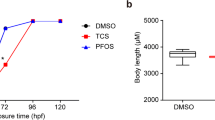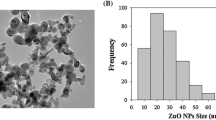Abstract
Pharmaceuticals are continually released in the environment and therefore pollution from drugs is a pressing problem in the environment. Diclofenac, 2-[(2,6-dichlorophenyl)amino]phenylacetic acid is a FDA approved non-steroidal anti-inflammatory drug (NSAID) for the treatment of inflammation. This pharmaceutical has been found as pollutant in superficial waters. Danio rerio (zebrafish) embryo has been used as a model organism for acute pollutant toxicity tests in order to identify morphological alterations in development and death rate. Through the combination of mRNA differential display and quantitative Real Time experiments, we analyzed the alterations of gene expression in zebrafish embryos left to develop in the presence of diclofenac and thereby assess the molecular mechanism involved in ecotoxicity of diclofenac polluted waters. This approach, in embryos exposed to 1.25 mg/l drug for 48 h, allowed identifying 36 different genes, with both known and unknown functions, whose transcription is differentially regulated. The identity and ontological classification of these genes is presented. The wide variety of functional classes of transcripts isolated in this screen reflects the diverse spectrum of influences operating across diclofenac exposure. Of these 36 genes, several have been selected for detailed quantitative Real Time analysis to validate the screen. Our results, for the first time, provide an insight into some of the varied and novel molecular networks following zebrafish exposure to diclofenac polluted waters.






Similar content being viewed by others
References
Kreisberg J (2005) Ecological healing and the web of life. Explore: J Sci Heal 1(2):133–135
Dietrich S, Ploessl F, Bracher F, Laforsch C (2010) Single and combined toxicity of pharmaceuticals at environmentally relevant concentrations in Daphnia magna—a multigenerational study. Chemosphere 79(1):60–66
Moldovan Z, Chira R, Alder AC (2009) Environmental exposure of pharmaceuticals and musk fragrances in the Somes River before and after upgrading the municipal wastewater treatment plant Cluj-Napoca, Romania. Environ Sci Pollut Res Int. 16(Suppl 1):S46–S54
Heberer T, Schmidt-Bäumler K, Stan HJ (1998) Occurrence and distribution of organic contaminants in the aquatic system in Berlin. Part I: drug residues and other polar contaminants in Berlin surface and ground water. Acta hydrochimica et hydrobiologica 26(5):272–278
Fent K, Weston AA, Caminada D (2006) Ecotoxicology of human pharmaceuticals. Aquat Toxicol 76:122–159
Wiegel S, Aulinger A, Brockmeyer R, Harms H, Löffler J, Reincke H, Schmidt R, Stachel B, von Tümpling W, Wanke A (2004) Pharmaceuticals in the river Elbe and its tributaries. Chemosphere 57:107–126
Daneshvar A, Svanfelt J, Kronberg L, Weyhenmeyer GA (2010) Winter accumulation of acidic pharmaceuticals in a Swedish river. Environ Sci Pollut Res Int 17:908–916
Kallio JM, Lahti M, Oikari A, Kronberg L (2010) Metabolites of the aquatic pollutant diclofenac in fish bile. Environ Sci Technol 44:7213–7219
Ericson H, Thorsén G, Kumblad L (2010) Physiological effects of diclofenac, ibuprofen and propranolol on Baltic Sea blue mussels. Aquat Toxicol 99:223–231
Hallare AV, Köhler HR, Triebskorn R (2004) Developmental toxicity and stress protein responses in zebrafish embryos after exposure to diclofenac and its solvent, DMSO. Chemosphere 56:659–666
van den Brandhof EJ, Montforts M (2010) Fish embryo toxicity of carbamazepine, diclofenac and metoprolol. Ecotoxicol Environ Saf 73:1862–1866
Scholz S, Fischer S, Gündel U, Küster E, Luckenbach T, Voelker D (2008) The zebrafish embryo model in environmental risk assessment—applications beyond acute toxicity testing. Environ Sci Pollut Res Int 15:394–404
Coverdale LE, Lean D, Martin CC (2004) Not just a fishing trip—environmental genomics using zebrafish. Curr Genomics 5:395–407
Yang L, Kemadjou JR, Zinsmeister C, Bauer M, Legradi J, Müller F, Pankratz M, Jäkel J, Strähle U (2007) Transcriptional profiling reveals barcode-like toxicogenomic responses in the zebrafish embryo. Genome Biol 8:R227
Ferrari B, Paxeus N, Lo Giudice R, Pollio A, Garric J (2003) Ecotoxicological impact of pharmaceuticals found in treated wastewaters: study of carbamazepine, clofibric acid, and diclofenac. Ecotoxicol Environ Saf 55:359–370
Haap T, Triebskorn R, Kohler H (2008) Acute effects of diclofenac and DMSO to Daphnia magna: Immobilisation and hsp70-induction. Chemosphere 73:353–359
Kallio JM, Lahti M, Oikari A, Kronberg L (2010) Metabolites of the aquatic pollutant diclofenac in fish bile. Environ Sci Technol 44:7213–7219
Medhurst AD, Chambers D, Gray J, Davis JB, Mason I, Jenner P, Newton R (2000) Practical aspects of the experimental design for differential display of transcripts obtained from complex tissues. In: Leslie RA, Robertson HA (eds) Differential display: a practical approach, vol 35. Oxford University Press, Oxford, p 64
Pathak RU, Kanungo MS (2007) Subtractive differential display: a modified differential display technique for isolating differentially expressed genes. Mol Biol Rep 34:41–46
Steinau M, Rajeevan MS (2009) RNA profiling in peripheral blood cells by fluorescent differential display PCR. In: Bugert P (ed) DNA and RNA profiling in human blood: methods and protocols, vol 496. Humana Press (a part of Springer Science+Business Media), Totowa, pp 211–222
Liang P, Pardee AB (1992) Differential display of eukaryotic messenger RNA by means of the polymerase chain reaction. Science 257:967–971
Lee SST, Tian L, Lee WS, Cheung WT (2002) Application of fluorescent differential display and peroxisome proliferator-activated receptor (PPAR)α-null mice to analyze PPAR target genes. Methods Enzymol 357:214–240
Bauer D, Muller H, Reich J, Riedel H, Ahrenkiel V, Warthoe P, Strauss M (1993) Identification of differentially expressed mRNA species by an improved display technique (DDRT-PCR). Nucleic Acids Res 21:4272–4280
Averboukh L, Douglas SA, Zhao S, Lowe K, Maher J, Pardee AB (1996) Better gel resolution and longer cDNAs increase the precision of differential display. Biotechniques 20:918–921
Sturtevant J (2000) Applications of differential-display reverse transcription-PCR to molecular pathogenesis and medical mycology. Clin Microbiol 13:408–427
Newton RA, Bingham S, Davey PD, Medhurst AD, Piercy V, Raval P, Parsons AA, Sanger GJ, Case CP, Lawson SN (2000) Identification of differentially expressed genes in dorsal root ganglia following partial sciatic nerve injury. Neuroscience 95:1111–1120
Thompson JD, Higgins DG, Gibson TJ (1994) CLUSTAL W: improving the sensitivity of progressive multiple sequence alignment through sequence weighting, position-specific gap penalties and weight matrix choice. Nucleic Acids Res 22:4673–4680
von Mering C, Jensen LJ, Kuhn M, Chaffron S, Doerks T, Kruger B, Snel B, Bork P (2007) STRING 7—recent developments in the integration and prediction of protein interactions. Nucleic Acids Res 35:D358–D362
Sambrook J, Fritsch EF, Maniatis T (1989) Molecular cloning: a laboratory manual. Cold Spring Harbor Laboratory, Cold Spring Harbor, New York
Snedecor GW, Cochran WG (1967) Statistical methods. Iowa State University Press, Ames, IA, pp 346–349
Swan GE, Cuthbert R, Quevedo M, Green RE, Pain DJ, Bartels P, Cunningham AA, Duncan N, Meharg AA, Oaks JL, Parry-Jones J, Shultz S, Taggart MA, Verdoorn G, Wolter K (2006) Toxicity of diclofenac to Gyps vultures. Biol Lett 2:279–282
Dietrich S, Ploessl F, Bracher F, Laforsch C (2010) Single and combined toxicity of pharmaceuticals at environmentally relevant concentrations in Daphnia magna-a multigenerational study. Chemosphere 79:60–66
Mehinto AC, Hill EM, Tyler CR (2010) Uptake and biological effects of environmentally relevant concentrations of the nonsteroidal anti-inflammatory pharmaceutical diclofenac in rainbow trout (Oncorhynchus mykiss). Environ Sci Technol 44:2176–2182
Triebskorn R, Casper H, Heyd A, Eikemper R, Köhler HR, Schwaiger J (2004) Toxic effects of the non-steroidal anti-inflammatory drug diclofenac. Part II: cytological effects in liver, kidney, gills and intestine of rainbow trout (Oncorhynchus mykiss). Aquat Toxicol 68:151–166
Triebskorn R, Casper H, Scheil V, Schwaiger J (2007) Ultrastructural effects of pharmaceuticals (carbamazepine, clofibric acid, metoprolol, diclofenac) in rainbow trout (Oncorhynchus mykiss) and common carp (Cyprinus carpio). Anal Bioanal Chem 387:1405–1416
Ferrari B, Paxéus N, Lo Giudice R, Pollio A, Garric J (2003) Ecotoxicological impact of pharmaceuticals found in treated waste waters: study of carbamazepine, clofibric acid, and diclofenac. Ecotoxicol Environ Saf 55:359–370
Skulachev VP (1998) Cytochrome c in the apoptotic and antioxidant cascades. FEBS Lett 423:275–280
Kratz E, Eimon PM, Mukhyala K, Stern H, Zha J, Strasser A, Hart R, Ashkenazi A (2006) Functional characterization of the Bcl-2 gene family in the zebrafish. Cell Death Differ 13:1631–1640
Popovic M, Zaja R, Loncar J, Smital T (2010) A novel ABC transporter: the first insight into zebrafish (Danio rerio) ABCH1. Mar Environ Res 69(Suppl):S11–S13
Long Y, Li Q, Cui Z (2011) Molecular analysis and heavy metal detoxification of ABCC1/MRP1 in zebrafish. Mol Biol Rep 38:1703–1711
Gonzalez P, Dominique Y, Massabuau JC, Boudou A, Bourdineaud JP (2005) Comparative effects of dietary methylmercury on gene expression in liver, skeletal muscle, and brain of the zebrafish (Danio rerio). Environ Sci Technol 39:3972–3980
Author information
Authors and Affiliations
Corresponding author
Rights and permissions
About this article
Cite this article
De Felice, B., Copia, L. & Guida, M. Gene expression profiling in zebrafish embryos exposed to diclofenac, an environmental toxicant. Mol Biol Rep 39, 2119–2128 (2012). https://doi.org/10.1007/s11033-011-0959-z
Received:
Accepted:
Published:
Issue Date:
DOI: https://doi.org/10.1007/s11033-011-0959-z




